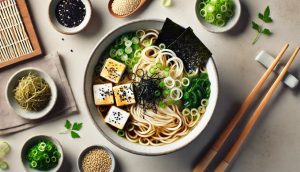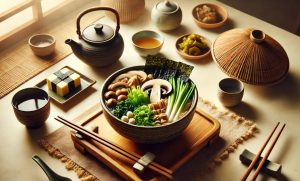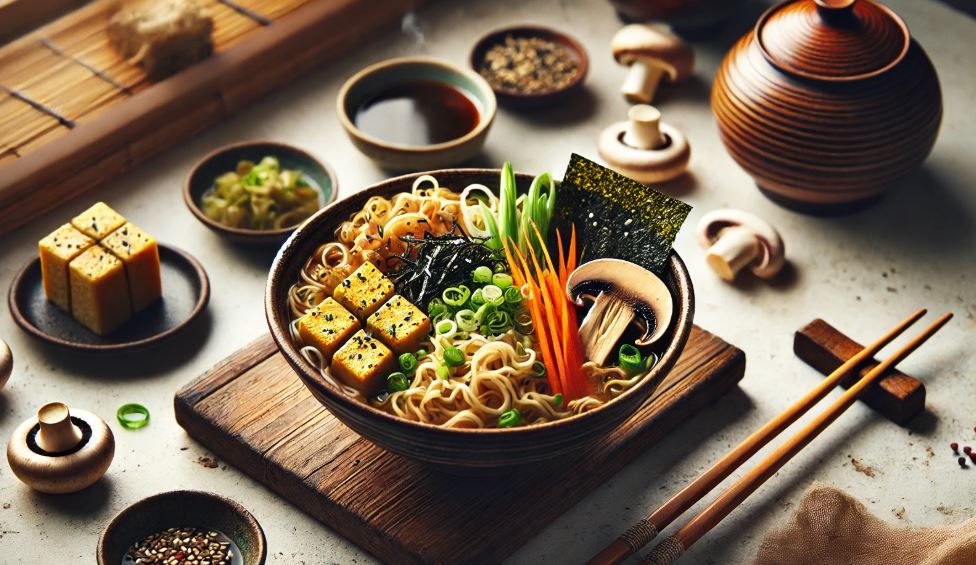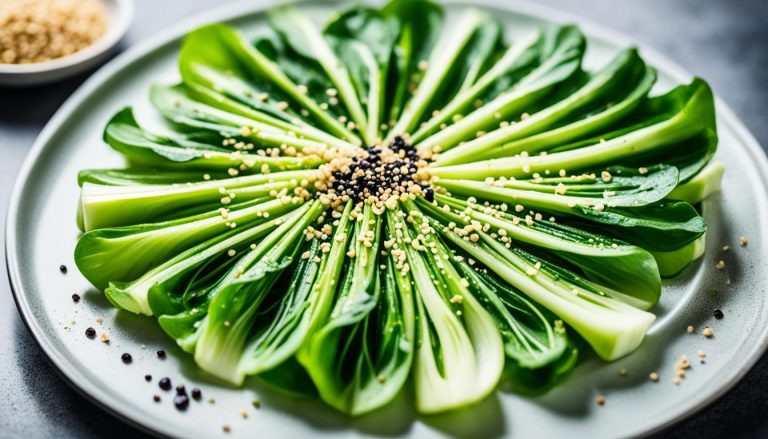Japanese Mounjaro is a classic Japanese dish celebrated for its rich broth, delicate spices, and harmonious blend of fresh ingredients. This comforting meal is perfect for chilly days or when you crave authentic Japanese flavours at home.
In this step-by-step guide, we’ll explore how to prepare a Japanese Mounjaro recipe with traditional techniques and chef-inspired variations that elevate its taste.
What is Japanese Mounjaro?
Japanese Mounjaro is a traditional dish deeply rooted in Japanese culinary heritage. Known for its rich, savoury broth and a delicate blend of spices, Mounjaro brings together ingredients that reflect the essence of Japanese cooking, umami, freshness, and simplicity.
While it may resemble dishes like Ramen or Udon, Mounjaro stands out due to its unique preparation method and flavour profile.
The dish is typically prepared with a robust broth simmered with a blend of Japanese spices, vegetables, and either meat or seafood, depending on the variation.
The origins of Japanese Mounjaro trace back to ancient Japanese villages where it was crafted as a comforting meal during colder seasons.
Its appeal grew over time, becoming a staple in many Japanese households. Today, it is often served in both family gatherings and fine dining settings, showcasing its versatility.
The texture of Mounjaro is smooth yet hearty, offering a perfect balance of soft noodles or rice, tender meat, and fresh vegetables. The broth is infused with kombu (kelp), miso, and dashi stock, providing a depth of flavour that is both rich and aromatic.
What Ingredients Are Needed for Japanese Mounjaro?
Below is a detailed breakdown of the essential ingredients required to craft an authentic Japanese Mounjaro:
| Ingredient | Quantity | Specification |
| Kombu (Dried Kelp) | 10g | For enhancing the umami flavour |
| Bonito Flakes | 15g | Adds richness to the broth |
| Miso Paste | 2 tbsp | Choose white or red miso for variation |
| Soy Sauce | 2 tbsp | Low-sodium preferred |
| Sake | 1 tbsp | For a touch of sweetness |
| Rice or Udon Noodles | 200g | Cooked separately |
| Shiitake Mushrooms | 50g | Fresh or dried, thinly sliced |
| Carrots | 1 medium | Julienned for texture |
| Spring Onions | 2 stalks | Finely chopped for garnish |
| Tofu (Optional) | 100g | Firm or silken, depending on preference |
| Seaweed Sheets (Nori) | 2 sheets | For garnish |
| Sesame Oil | 1 tsp | To enhance aroma |
| Fresh Ginger | 1 tsp, grated | Adds a slight zing |
| Garlic | 2 cloves, minced | For additional flavour |
| Salt | To taste | Adjust as needed |
| Black Pepper | To taste | For a mild spice kick |
Step-by-Step Guide to Cooking Japanese Mounjaro
Follow these detailed steps to bring your Japanese Mounjaro to life:
Prepare the Vegetables: Slice mushrooms, carrots, and spring onions into thin strips.

Cook the Noodles or Rice: Follow the package instructions for cooking, then set them aside.

Sauté the Aromatics: In a separate pan, heat sesame oil and sauté the grated ginger and minced garlic until fragrant.

Cook the Vegetables: Add the sliced vegetables to the pan and cook for about 5–7 minutes, or until they are tender yet crisp.

Combine with Broth: Pour the prepared broth over the vegetables and let it simmer for an additional 10 minutes to allow the flavours to meld.

Serve and Garnish: Serve hot with the cooked noodles or rice, topping with spring onions, nori sheets, and tofu if desired.

How to Prepare the Perfect Japanese Mounjaro Broth?
Crafting the perfect broth is the cornerstone of a good Japanese Mounjaro. This broth is simmered to extract maximum flavour from its key ingredients, creating a base that is rich, aromatic, and deeply savoury.
Steps to Prepare the Broth
- Rinse the Kombu: Start by rinsing the kombu (dried kelp) under cold water to remove any surface impurities.
- Simmer the Kombu: In a large pot, add the kombu along with 4 cups of water. Heat gently for about 10 minutes. Make sure the water does not reach a boil, just a gentle simmer.
- Add Bonito Flakes: Remove the kombu and add bonito flakes. Let them simmer for another 5 minutes. The bonito flakes will infuse the water with a smoky, umami-rich flavour.
- Strain the Broth: Strain the broth to remove the flakes, leaving you with a clear and flavourful dashi stock.
- Add Miso and Soy Sauce: Return the broth to the pot and stir in miso paste, soy sauce, and sake until fully dissolved.
- Final Simmer: Allow the broth to simmer gently for another 10 minutes, ensuring all the flavours meld together perfectly.
This preparation results in a broth that is both light and deeply flavourful, the perfect base for the rest of the dish.
Which Japanese Spices Are Essential for Mounjaro?
Japanese Mounjaro derives its distinctive flavour from a combination of traditional spices. Each spice contributes to the depth and complexity of the dish, enhancing its umami profile. Below are the key spices that are essential for an authentic Japanese Mounjaro experience:
- Shichimi Togarashi (Japanese Seven Spice): A popular Japanese spice blend that includes red chili pepper, sesame seeds, orange peel, ginger, and nori. It adds a hint of spiciness and a subtle citrus aroma to the broth.
- Sansho Pepper: Known for its numbing heat and citrusy flavour, sansho pepper is often used to elevate the sharpness of the broth.
- White Pepper: Milder than black pepper, white pepper provides a soft heat that complements the savoury flavours of the dish.
- Yuzu Kosho (Citrus Chili Paste): A mix of yuzu zest and chili, adding both a tangy and spicy element to Mounjaro. This is typically used as a garnish for an added kick.
These spices are best added during the simmering process to fully infuse their flavours into the broth. A dash of shichimi togarashi at the end also enhances the final presentation.
What Type of Broth is Best for Mounjaro Preparation?
The choice of broth is crucial in preparing Japanese Mounjaro, as it serves as the foundation for the dish’s flavour. Here are the recommended types of broth:
- Dashi Broth: This is the traditional Japanese broth made from kombu (dried kelp) and bonito flakes. It has a light, umami-rich base that is perfect for Mounjaro. Dashi is simmered gently to extract maximum flavour without bitterness.
- Chicken Broth: If you prefer a richer and meatier taste, chicken broth is an excellent alternative. It adds more body to the soup, making it heartier.
- Vegetable Broth: For a vegan or vegetarian option, vegetable broth serves as a suitable replacement. To intensify the flavour, you can simmer the broth with shiitake mushrooms and dried seaweed.
The broth is typically simmered slowly to ensure the flavours meld together seamlessly. For the best results, avoid boiling, as this can turn the broth cloudy and bitter.
Are There Any Special Vegetables Used in Mounjaro?
Japanese Mounjaro is often prepared with a selection of fresh, locally sourced vegetables that not only enhance the flavour but also add texture and nutrition to the dish. Some of the most common vegetables include:
- Daikon Radish: Adds a mild, slightly peppery flavour and a soft texture when simmered.
- Bamboo Shoots: Provide a crunchy contrast to the broth’s smoothness.
- Enoki Mushrooms: These delicate mushrooms offer a slightly earthy taste and a unique, stringy texture.
- Spinach: Adds a vibrant green colour and a touch of bitterness that balances the savoury broth.
These vegetables are typically added during the final simmering process to retain their texture and nutritional value.
Chef’s Variations of Japanese Mounjaro
Japanese Mounjaro is a versatile dish that can be adapted to suit various tastes and dietary preferences. Here are some popular chef-inspired variations:
- Classic Japanese Mounjaro: Uses traditional ingredients with a clear broth and subtle umami flavours.
- Spicy Mounjaro Fusion: Incorporates chili oil and shichimi togarashi for a bold, spicy kick.
- Vegan Mounjaro Twist: Dashi is replaced with vegetable broth, and extra mushrooms are added for a hearty, plant-based version.
- Seafood Mounjaro Delight: Fresh prawns, squid, or thin slices of fish are simmered in the broth for a coastal-inspired taste.
These variations allow you to experiment with the core recipe while keeping its authentic Japanese essence intact.
How to Serve Japanese Mounjaro for the Best Experience?

Japanese Mounjaro is traditionally served hot and fresh. For the best dining experience:
- Garnish with spring onions, sesame seeds, and nori strips.
- Add a soft-boiled egg sliced in half for richness.
- Serve with side dishes like pickled radish, steamed edamame, or gyoza.
To enhance the experience, pair it with a light Japanese green tea or sake.
Nutritional Benefits of Japanese Mounjaro
| Nutrient | Per Serving |
| Calories | 320 kcal |
| Protein | 12g |
| Carbohydrates | 45g |
| Fat | 8g |
| Dietary Fiber | 5g |
| Sodium | 850mg |
| Vitamin A | 15% RDI |
| Vitamin C | 10% RDI |
| Iron | 8% RDI |
Tips and Tricks for Enhancing the Flavour of Mounjaro
- Always use fresh kombu and bonito flakes for the broth to avoid a stale taste.
- Simmer gently to prevent bitterness in the broth.
- A splash of mirin can add subtle sweetness and depth.
- Finish with sesame oil for a fragrant, nutty aroma.
Common Mistakes to Avoid When Making Japanese Mounjaro
- Overcooking the broth: This can lead to a bitter taste.
- Adding miso paste too early: Miso should be added towards the end of the cooking process to maintain its rich flavour.
- Boiling kombu: Kombu should only be simmered; boiling can make it slimy and release unwanted bitterness.
Conclusion
Japanese Mounjaro is a testament to the elegance and simplicity of Japanese cuisine. Whether enjoyed in its classic form or with a modern twist, its savoury broth and fresh ingredients make it a satisfying dish for any occasion. Try this recipe at home, and experience the warmth and comfort of authentic Japanese flavours.
Frequently Asked Questions About Japanese Mounjaro
What is the best way to store leftovers?
Japanese Mounjaro can be refrigerated for up to 3 days in an airtight container. Reheat gently to avoid overcooking.
Can I freeze Mounjaro?
Yes, but it’s best to freeze the broth separately from the noodles.
How do I make Mounjaro gluten-free?
Use gluten-free soy sauce and rice noodles instead of wheat-based noodles.
What protein options work well with Mounjaro?
Chicken, tofu, seafood, and even pork slices pair wonderfully.
Can I make Mounjaro spicy?
Absolutely! Add chili oil or shichimi togarashi to the broth for extra heat.
What side dishes go well with Mounjaro?
Try pickled vegetables, gyoza, or steamed edamame.
Is Mounjaro suitable for vegetarians?
Yes, simply replace the dashi with vegetable broth.

Japanese Mounjaro Recipe
Ingredients
- 10 g Kombu For enhancing the umami flavour
- 15 g Bonito Flakes Adds richness to the broth
- 2 tbsp Miso Paste Choose white or red miso for variation
- 2 tbsp Soy Sauce Low-sodium preferred
- 1 tbsp Sake For a touch of sweetness
- 200 g Rice or Udon Noodles Cooked separately
- 50 g Shiitake Mushrooms thinly sliced
- 1 medium Carrots Julienned for texture
- 2 stalks Spring Onions 2 stalks Finely chopped for garnish
- 100 g Tofu Firm or silken, depending on preference
- 2 sheets Seaweed Sheets For garnish
- 1 tsp Sesame Oil To enhance aroma
- 1 tsp Fresh Ginger grated
- 2 cloves Garlic minced
- Salt To taste Adjust as needed
- Black Pepper To taste
Instructions
- Prepare the Vegetables: Slice mushrooms, carrots, and spring onions into thin strips.50 g Shiitake Mushrooms, 1 medium Carrots, 2 stalks Spring Onions 2 stalks
- Cook the Noodles or Rice: Follow the package instructions for cooking, then set them aside.200 g Rice or Udon Noodles
- Sauté the Aromatics: In a separate pan, heat sesame oil and sauté the grated ginger and minced garlic until fragrant.2 tbsp Soy Sauce, 1 tsp Sesame Oil, 1 tsp Fresh Ginger, 2 cloves Garlic, 1 tbsp Sake
- Cook the Vegetables: Add the sliced vegetables to the pan and cook for about 5–7 minutes, or until they are tender yet crisp.Salt To taste, Black Pepper
- Combine with Broth: Pour the prepared broth over the vegetables and let it simmer for an additional 10 minutes to allow the flavours to meld.15 g Bonito Flakes, 10 g Kombu
- Serve and Garnish: Serve hot with the cooked noodles or rice, topping with spring onions, nori sheets, and tofu if desired.2 tbsp Miso Paste, 100 g Tofu, 2 sheets Seaweed Sheets









